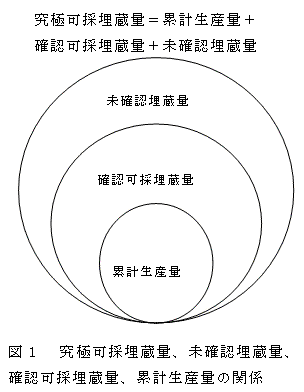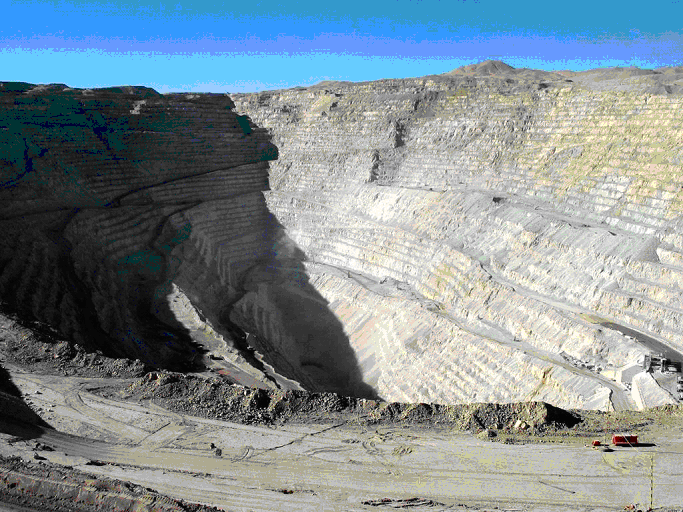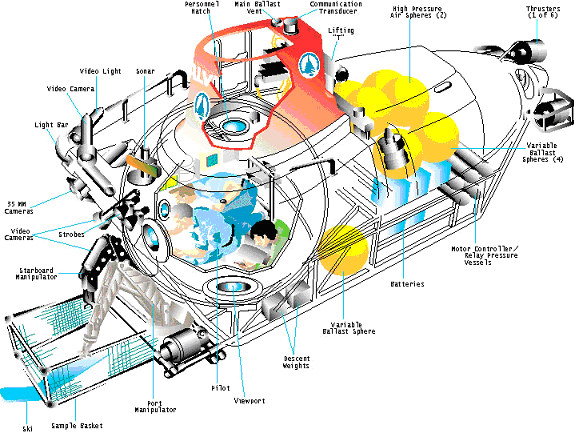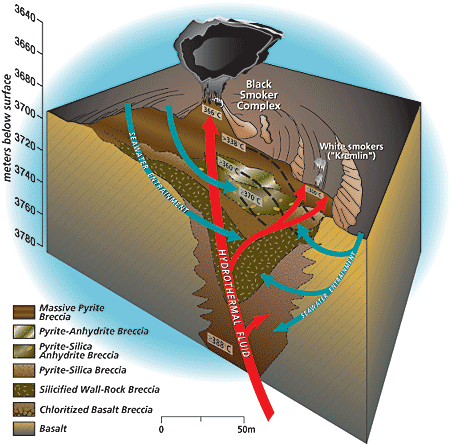 福岡(2007)による『地球資源』から |
戻る<1|2|3|4|5|6|7|8|9|10|11|12|13|14|15<
|
|
| 配付プリント等 |
| 補足説明 |
|
|
| エネルギー資源 | 化石燃料(石油、石炭、天然ガス、オイルシェール) |
| 放射性物質 | |
| 地熱 | |
| 太陽熱・太陽光 | |
| 水(水力) | |
| 風(風力) | |
| バイオマス(燃料木、林産加工廃棄物、都市ゴミ) | |
| 鉱物資源 | 金属 |
| 非金属 | |
| 生物資源 | 食糧(農作物、畜産物、水産物) |
| 森林(森林生態系も含む) | |
| 水資源 | |
| 土壌資源 | |
|
|
|
【究極可採埋蔵量】
枯渇性(非再生)資源の場合、現在利用できる量は確認可採埋蔵量で表されるのが一般的であるが、将来的に利用可能な量は究極可採埋蔵量と呼ばれることがある。これは、既に利用済みの量(累計生産量、累積生産量)に確認可採埋蔵量と未確認埋蔵量を加えたものとして定義されている。つまり、最も不確かな量は未確認埋蔵量であるが、通常は究極可採埋蔵量の方で議論されることが普通である。究極可採埋蔵量は、過去の探査結果等を将来へ外挿して推定する方法や、自然科学的(地質学的)な資源の成因論を基にして推定する方法等があるが、研究者(研究組織)によって結果が非常に異なる場合も多く、楽観的か悲観的かというような見積り方の立場の違い等も大きく影響する。従って、いくつかの主要な資源(例えば、石油、など)以外は、詳細な検討は行なわれていない。
 福岡(2007)による『地球資源』から |
| 参考 |
 チリのチュキカマタ銅鉱山(1990年代まで世界最大の露天掘りの鉱山) 〔Paul Harris氏によるChuquicamataから〕 露天掘りによる採掘跡(オープンピット)の大きさは4.3キロメートル×3キロメートル×850メートル(深さ)に達する。 |
 Specifications 〔Woods Hole Oceanographic InstitutionによるMarine Operationsの『NDSF Vehicles』の中の『Alvin』から〕 全長約7メートルで、17トン程度である。4500メートルまで潜れる。 |
 In this schematic drawing of the TAG active hydrothermal mound, hydrothermal fluid rises rapidly and exits the mound at the Black Smoker Complex. Cold calcium- and sulfate-rich seawater is entrained into the mound, where it mixes with hydrothermal fluid. The mixing causes anhydrite, pyrite, and chalcopyrite to precipitate inside the mound. This precipitation increases the acidity of the hydrothermal fluid. Zinc and other elements, such as silver, gold, and cadmium, dissolve in this acidic fluid, allowing them to be carried by the white smoker fluid to the edges of the mound at the "Kremlin" area. Here the cooler temperatures within white smoker chimney walls cause the elements to precipitate. 〔Woods Hole Oceanographic InstitutionのDeep Ocean Exploration Instituteの『Related Topics』の中の『Hydrothermal Vent Systems』から〕 海底に噴出した熱水(300℃以上:圧力が高ければ100℃以上でも液体として存在できる)は急激に冷却され(海水温は2℃程度)、熱水に溶けていた物質が固体の鉱物として晶出・沈殿する。硫化鉱物〔鉄(黄鉄鉱、pyrite、FeS2)・銅(黄銅鉱、chalcopyrite、CuFeS2)・鉛(方鉛鉱、galena、PbS)・亜鉛(閃亜鉛鉱、sphalerite、ZnS)の硫化鉱物が多い:金や銀なども少量伴うことがある〕が多く、これらは細粒では黒く見えるので、ブラック・スモーカーと呼ばれる。 |